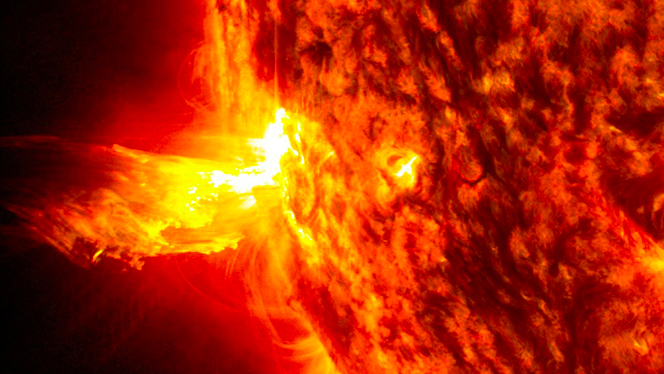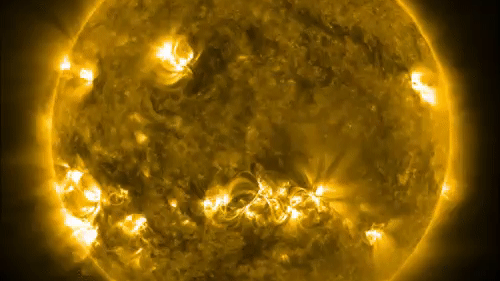Could a solar storm ever destroy Earth?
Our planet has one huge advantage in the fight against space weather.

All life on Earth owes its existence to the sun's radiant heat. But what happens when that radiation surges out of control, and billions of tons of charged solar material suddenly barrel our way at thousands of miles a second? What happens when Earth takes a direct hit from a solar flare — and could a strong enough one ever destroy life on our planet as we know it?
The answers are complicated, but most scientists agree on one thing: Earth's magnetic field and insulating atmosphere keep us extremely well protected from even the most powerful solar outbursts. While solar storms can tamper with radar and radio systems or knock satellites offline, the most harmful radiation is sopped up in the sky long before it touches human skin.
"We live on a planet with a very thick atmosphere… that stops all of the harmful radiation that is produced in a solar flare," said Alex Young, Associate Director for Science in the Heliophysics Science Division at NASA's Goddard Space Flight Center in Greenbelt, Maryland. "Even in the largest events that we've seen in the past 10,000 years, we see that the effect is not enough to damage the atmosphere such that we are no longer protected," Young said in a 2011 video addressing fears that a solar flare would end the world in 2012.
Still, not all solar flares are harmless. While Earth’s magnetic field prevents widespread death from solar radiation, the sheer electromagnetic power of a flare could disrupt power grids, internet connections and other communication devices on Earth, resulting in chaos and potentially even death. Space weather experts at NASA and other agencies take this threat seriously, and closely monitor the sun for potentially hazardous activity.

What are solar flares?
Solar flares occur when the sun's magnetic field lines become taut and twisted, causing enormous, planet-sized storms of electromagnetic energy to form on the sun's surface. We can see these storms as cold, dark splotches known as sunspots. Around sunspots, huge tendrils of magnetic field lines twist, spool and sometimes snap, creating powerful flashes of energy, or solar flares.
Most energy from a solar flare is radiated away as ultraviolet and X-ray light, Live Science previously reported. However, the intense energy of a flare can also heat up nearby gas in the sun's atmosphere, launching enormous blobs of charged particles known as coronal mass ejections (CMEs) out into space. If a flaring sunspot happens to be facing Earth, then any resulting CMEs blast right toward us, typically reaching our planet in anywhere from 15 hours to several days.
Whether or not you've heard of CMEs, you've likely lived through hundreds of them; the sun emits anywhere from one CME each week to several a day, depending on where we are in the sun's 11-year cycle of activity, according to NASA. Most CMEs pass over our planet completely undetected by the general public, thanks to Earth's powerful magnetic field, or magnetosphere.
Get the world’s most fascinating discoveries delivered straight to your inbox.
However, the biggest, most energetic CMEs can actually compress our planet's magnetic field as they pass, resulting in what's known as a geomagnetic storm.
As electromagnetic energy from the sun pours into our magnetosphere, atoms and molecules in Earth's atmosphere become electrically charged, creating effects that can be seen around the world. During such storms, the aurora borealis, typically only seen near the North Pole, can shift down so far that it becomes visible near the equator.
Radio and radar systems around the world can black out, and electrical grids may become overloaded and lose power. Some experts fear that a sufficiently large CME could create an "internet apocalypse" by overloading undersea internet cables and leaving parts of the world without web access for weeks or months, though this has not happened yet. Satellites and space stations, which orbit beyond the protection of Earth's atmosphere, can also be debilitated by the renegade radiation of CMEs.
Still, even the most powerful geomagnetic storm in recorded history — the 1859 Carrington Event — had no noticeable impact on the health of humans or other life on Earth. If even stronger solar storms battered our planet before this, there is no evidence that they impacted human health either.
"No matter what, flares do not have a significant effect on us here on Earth," Doug Biesecker, a researcher at the National Oceanic and Atmospheric Administration's Space Weather Prediction Center, told the Stanford Solar Center. "What sort of fluxes would have to strike the Earth to wipe us out? I don't know the answer to that, but obviously, we've never even observed a solar event big enough to have any measurable effects on human health."
Star damage
Our nearest star may not pose an extinction threat – but scientists suspect that other nearby stars could. When certain stars run out of fuel and die, they explode in a tremendous supernova that blasts powerful radiation into space for millions of light-years around. These blasts are many, many times more powerful that solar flares; should such an explosion occur sufficiently close to Earth, the dying star could bathe our planet in so much ultraviolet radiation that it strips our protective ozone layer away, making Earth vulnerable to a barrage of charged interstellar particles.
The authors of a recent study (published in the Proceedings of the National Academy of Sciences in Aug. 2020) suspect that the death of a star within 65 light-years of Earth may have done just that about 359 million years ago, at the end of the Devonian Period (416 million to 358 million years ago). A mass extinction at the end of this period resulted in the death of 70% of Earth’s invertebrates, though scientists are not certain what triggered it. However, an examination of fossil spores from the time of the extinction revealed signs of ultraviolet light damage – suggesting that perhaps an exploding star triggered the extinction.
Fortunately, there are no supernova candidates close enough to Earth to pose such a threat anytime soon, the study authors reassured. We have only our warm little sun to worry about – and our atmosphere makes sure that we stay on that star’s friendly side.
Originally published on Live Science.

Brandon is the space / physics editor at Live Science. With more than 20 years of editorial experience, his writing has appeared in The Washington Post, Reader's Digest, CBS.com, the Richard Dawkins Foundation website and other outlets. He holds a bachelor's degree in creative writing from the University of Arizona, with minors in journalism and media arts. His interests include black holes, asteroids and comets, and the search for extraterrestrial life.


